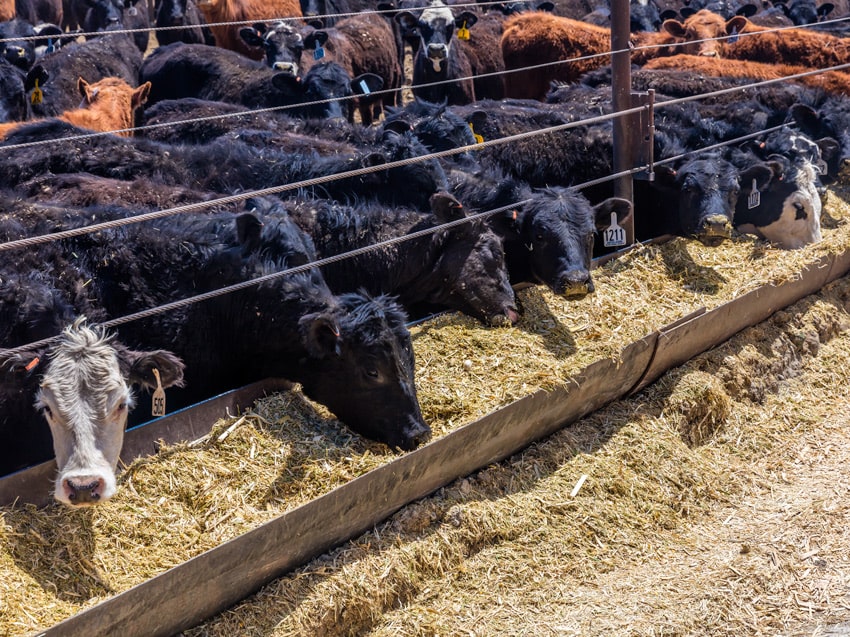Safety Training in Feedyards
By Jackie Ostrowicki
March 2021
In Nebraska, cattle outnumber Nebraskans nearly 4 to 1. Cattle production is an engine that helps power the state's economy, with over $6.5 billion in cattle sales each year. Nearly 5 million head are finished and marketed in Nebraska each year. Many of these cattle are raised on feedyards, and working on these feedyards can be dangerous.
Athena Ramos wants to reduce the amount of injuries experienced at feedyards. Ramos is an assistant professor in the UNMC Department of Health Promotion and a lifelong Nebraskan.
"Each of us has power to influence our communities or neighbors and change things for the better," Ramos said. "Throughout my career, I've been focused on bringing people together around common issues—whether that's engaging around tobacco control or organizing workers to provide information around workplace safety."

Workplace safety is an everyday factor in agriculture. For more than a decade, agriculture has been the most hazardous industry in the US, with the cattle feedyard subsector experiencing high injury and illness rates. These rates are partly due to high turnover among feedyard employees. Some come to work in the industry with little experience and no safety training, and many come from other countries with limited language skills.
"A majority of farm workers across the country are Latinos and foreign-born individuals; I specialize in Latino health and immigrant health disparities," said Ramos. "I feel I can make a real difference in the agricultural safety and health field."
Reducing Injury and Illness in Feedyards
Ramos is currently involved in two feedyard projects at UNMC funded by the Central States Center for Agricultural Safety and Health (CS-CASH)—one is Feedyard 15, which Dr. Aaron Yoder leads and she supports, and the other is Health and Safety Risks Among Immigrant Cattle Feedlot Workers, which she leads. "Cattle feeding is a huge economic generator," she said. "It made sense to focus on an industry and issue right here in our back yard. Very few research projects have addressed health and safety issues in the feedyard sector."
The Feedyard 15 is a set of safety training modules that cover the 15 most dangerous tasks in the feedyard. It looks to expand feedyard managers' and workers' understanding and knowledge of how injuries are caused—and how to prevent them.
"A majority of farm workers across the country are Latino and foreign-born individuals; I specialize in Latino health, health disparities and immigrant health disparities. I felt I could make a real difference in the agricultural safety and health field."
—Dr. Athena Ramos
The modules were developed over the past two years, based on research. Yoder and Ramos's team analyzed worker's compensation claims to see where injuries clustered. They also used ethnography, interviewing workers and studying them in the feedyard environment.
The resulting modules cover topics that range from horsemanship and processing cattle to ATVs and manure lagoons. They are available in English and Spanish, and have a quiz at the end to ensure the information was clearly understood. They also contain supplemental materials, such as resources for farm safety. These modules allow feedyards to organize on-site trainings and personalize them to meet their individual operational needs; feedyard managers can select the applicable training lesson and set a training time that works for their employees.
There are 254 feedyards in Nebraska; eight of which are participating in the study. Ramos and Yoder are still testing the modules, and hope to make them available more widely later this year. Following testing, the modules will be available free-of-charge to all feedyards across the US to be used in their safety trainings.
"Estimates put foreign-born and Latino workers to be 50% of the livestock production workforce, and industry leaders have shared that culturally appropriate resources are needed," Ramos said.
Making an Impact
Yoder and Ramos are partnering with Gallagher Insurance in Omaha to measure how lowered injuries could reduce workman's compensation costs. "By applying safety program and lowering injuries, we may be able to lower the costs of workman's comp insurance," Yoder said.
They are also partnering with Nebraska Cattlemen's Association. Bonita Lederer, Director of Producer Education for Nebraska Cattlemen said, "Keeping our feedyard employees safe is important to our livestock producers. Labor issues are challenging for feedyards, and if we can reduce the number of injuries to workers, we'll keep our workers on the job. Offering educational materials and training like Feedyard 15 to employees helps them feel safe at work and maintains a healthy working relationship."
According to Ramos, for many years, feedyard managers struggled to find this kind of information. Some fee-for-service programs are available, but they can be cost-prohibitive and out of reach for smaller feedyards. Feedyard 15 is no-cost because of grant funding. "I'm very proud of this program," she said. "We'd like to make it self-sustainable so we don't have to use grant funding and then transition to other industries, such as poultry."
Her hope is that these projects will result in improved health and safety in the cattle feeding industry. "We want to create relevant trainings and make sure they are appropriate for the feedyard workforce and the changing demographics of that workforce," Ramos said.
Editors Note: Ramos is now an associate professor in the UNMC Department of Health Promotion.
Discover our Podcast Series
The “Leading Nebraska” podcast shares the stories of the researchers, students, teachers and others across the University of Nebraska's four campuses who are making an impact. From teachers and doctors to engineers and ag experts, these Nebraska leaders are touching lives and making a difference.